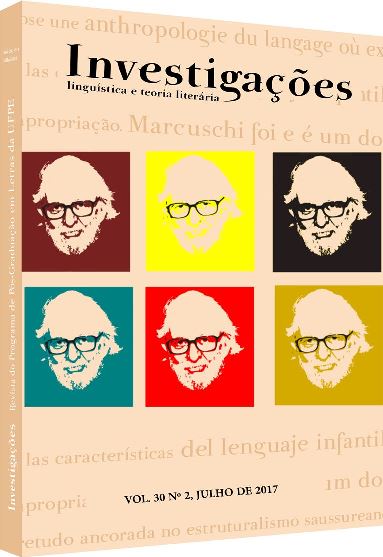Luiz Antônio Marcuschi e a imortalidade do diálogo
DOI:
https://doi.org/10.51359/2175-294x.2017.231638Resumo
Apresentação da Edição Especial em homenagem a Luiz Antônio MarcuschiReferências
BORGES, Jorge Luis. Cinco visões pessoais. Brasília: Editora Universidade de Brasília, 1996, p.13-20.
______. Esse ofício do verso. São Paulo: Companhia das Letras, 2000, p. 10-28.
FILLMORE, C.J. Frame Semantics. In Linguistics in the Morning Calm. Seoul, Hanshin Publishing Co, p.111-137, 1982.
FAUCONNIER, Gilles. Mental Spaces: aspects of meaning construction in natural language. Cambridge: Cambridge University Press, 1994.
GUMPERZ, John. Discourse strategies. Cambridge: Cambridge University Press, 1982.
HALLIDAY, Michael e Ruqaiya Hasan. Cohesion in English. New York: Routledge, 1976.
HAUSER, Mark; Noam CHOMSKY; Tecumseh FITCH. The faculty of language: what is it, who has it, and how did it evolve? Science, 298, 1569-1579, 2002.
MARCUSCHI, Luiz Antonio. Apresentação. In Ingedore Villaça Koch e Kazue Sato Monteiro de Barros, organizadoras. Tópicos em linguística de texto e análise da conversação. Natal: EDUFRN, 1997, p.7-8, 1997.
SACKS, Harvey; Emanuel SCHEGLOFF; Gail JEFFERSON. A simplest systematics for the organization of turn-taking for conversation. Language, 50, 696-735. 1974.
TOMASELLO, Michael. The cultural origins of human cognition. Cambridge: Harvard University Press, 1999.
______. Origins of human communication. Cambridge: MIT Press, 2008.
______. A natural history of human thinking. Cambridge: Harvard University Press, 2014.
______. A natural history of human morality. Cambridge: Harvard University Press, 2016.
Downloads
Publicado
Como Citar
Edição
Seção
Licença
Copyright (c) 2017 Maria Margarida Martins Salomão

Este trabalho está licenciado sob uma licença Creative Commons Attribution 4.0 International License.
Autores que publicam na Revista Investigações concordam com os seguintes termos:
Autores mantêm os direitos autorais e concedem à revista o direito de primeira publicação, com o trabalho simultaneamente licenciado sob a licença Creative Commons Atribuição 4.0 Internacional (CC BY 4.0) que permite o compartilhamento do trabalho com reconhecimento da autoria e publicação inicial nesta revista.
Autores têm autorização para assumir contratos adicionais separadamente, para distribuição não-exclusiva da versão do trabalho publicada nesta revista (exemplo: depositar em repositório institucional ou publicar como capítulo de livro), com reconhecimento de autoria e publicação inicial nesta revista.
Qualquer usuário tem direito de:
Compartilhar — copiar e redistribuir o material em qualquer suporte ou formato para qualquer fim, mesmo que comercial.
Adaptar — remixar, transformar e criar a partir do material para qualquer fim, mesmo que comercial.
O licenciante não pode revogar estes direitos desde que você respeite os termos da licença.
De acordo com os termos seguintes:
Atribuição — Você deve dar o crédito apropriado, prover um link para a licença e indicar se mudanças foram feitas. Você deve fazê-lo em qualquer circunstância razoável, mas de nenhuma maneira que sugira que o licenciante apoia você ou o seu uso.
Sem restrições adicionais — Você não pode aplicar termos jurídicos ou medidas de caráter tecnológico que restrinjam legalmente outros de fazerem algo que a licença permita.

